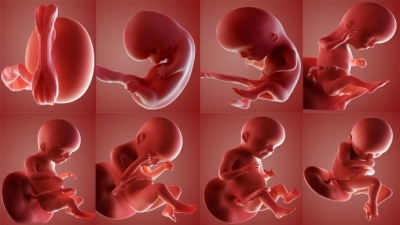
REPRODUCTION
Human beings have a limited lifespan but are able, through reproduction, to produce a new generation to succeed them. Male and female reproductive systems produce specialized sex cells — called sperm and eggs — that unites during fertilization and combines their genetic instructions to make a new, unique human. After fertilization the embryo — later called a fetus — grows and develops inside its mother’s uterus (womb) for the nine months of pregnancy.
- FERTILIZATION Inside a woman’s reproductive system, sperm swim towards and surround an egg and attempt to penetrate its outer layer. Eventually one succeeds, loses its tail, and its head fuses with the egg’s nucleus, thereby combining two sets of genetic instructions (DNA).
- CELLS MULTIPLY As the fertilized egg, or pre-embryo, is swept towards the uterus it divides repeatedly, producing first two cells, then four, then eight, and so on. Six days after fertilization it embeds itself in the uterus lining.
- FOUR WEEKS This pea-sized, four-week old embryo — its head is on the left — is growing in its mother’s uterus. Its tiny heart is beating and the nervous system and vital organs are forming.
- FIVE TO SIX WEEKS The embryo’s brain continues to develop, as do other organs, such as the intestines. Its skull and face are taking shape, and limbs, in the form of buds, are starting to grow. The embryo floats within a sac filled with protective fluid.
- SEVEN WEEKS The bones of the grape sized embryo start to harden and muscles develop and get stronger. Wrists and ankles are now visible and fingers and toes are just starting to appear. Internally, the kidneys start to remove waste to make urine.
- TEN WEEKS Now 500 times bigger than a fertilized egg and consisting of billions of cells of different types, the fetus, as it is now called, has all its basic organs in place and is growing rapidly. Its large head accommodates a fast-expanding brain. Fingers have formed and fingernails are growing.
- TWELVE WEEK Since their implantation, the cells have been growing and specializing and the tiny individual they have molded is now recognizably human. It has facial features, and fingers and toes have separated. The internal organs are in place, and the heart is beating.
- TWENTY WEEKS Fingers and ears clearly visible, the movements of the fetus can be felt by its mother inside her expanding uterus. The fetus blinks and swallows and follows phases of sleeping and waking. The ridges that produce fingerprints appear on its fingertips.
- THIRTY WEEKS Ultrasound scanning is a safe method used to monitor the development of a fetus, and can also reveal whether it is a girl or boy. At this stage, the brain is still growing rapidly. The fetus can hear sounds and its eyes respond to light. Its lungs can now potentially breathe air.
- NEWBORN As pregnancy comes to an end, the uterus contracts to push the fully grown fetus into the bright, noisy outside world. The newborn baby takes its first breath and the umbilical cord is cut. In the next phases of its growth and development the baby is completely dependent on its parents for food, warmth, and protection.
Picture Credit : Google



